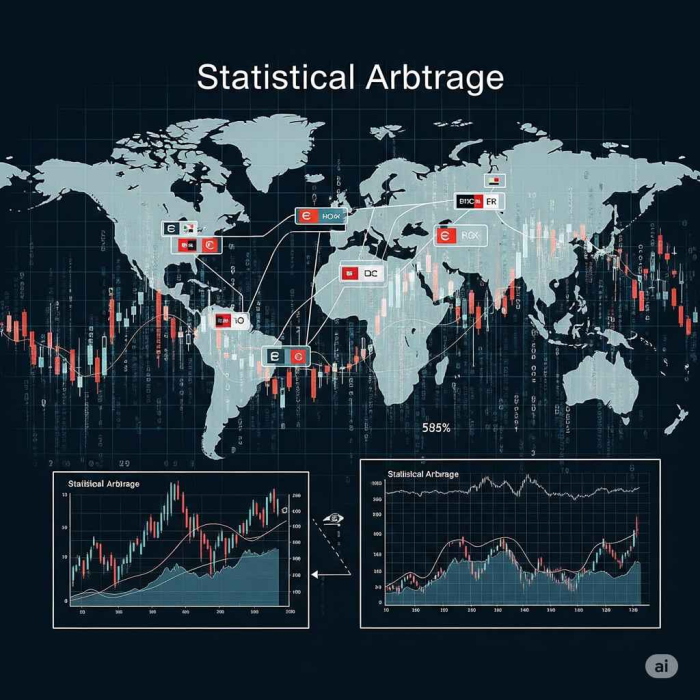Unlocking Alpha in Currency Markets | An Introduction to Statistical Arbitrage in Forex
The foreign exchange (Forex) market, with its immense liquidity and constant fluctuations, often appears as a chaotic dance of supply and demand. Yet, beneath the surface, subtle inefficiencies and predictable patterns can emerge. For quantitative traders, these anomalies present opportunities for "statistical arbitrage" – a strategy that seeks to profit from temporary deviations from historical relationships between currency pairs.
While the concept might sound complex, the core idea is elegantly simple: identify situations where the price relationship between two or more currency pairs diverges from its statistically expected norm, take a position to profit from its eventual reversion, and then close the trade when the relationship normalizes.

What is Statistical Arbitrage?
At its heart, statistical arbitrage is a mean-reversion strategy. Unlike pure arbitrage, which exploits risk-free price discrepancies, statistical arbitrage carries some risk. It relies on the statistical likelihood that a mispricing will correct itself over time. In Forex, this often involves:
- Cointegration: This is a key concept. If two or more currency pairs are "cointegrated," it means they tend to move together in the long run, even if they diverge in the short term. Their spread (the difference between their prices or a linear combination of their prices) will be stationary, meaning it fluctuates around a stable mean. When the spread deviates significantly from this mean, a statistical arbitrage opportunity arises.
- Pairs Trading: The most common form of statistical arbitrage, pairs trading in Forex involves identifying two highly correlated currency pairs. For example, if EUR/USD and GBP/USD historically move in lockstep, and suddenly EUR/USD goes up while GBP/USD lags, a trader might short EUR/USD and long GBP/USD, expecting the spread to revert.
- Basket Trading: This involves a more complex relationship between multiple currency pairs, where a statistical model predicts the equilibrium relationship between them. When the market deviates from this equilibrium, trades are executed to bring the portfolio back into balance.
Why Forex for Statistical Arbitrage?
Several characteristics of the Forex market make it an attractive hunting ground for statistical arbitrageurs:
- High Liquidity: The sheer volume of trading ensures that even large positions can be entered and exited without significant price impact.
- 24/5 Operation: The continuous nature of the market provides ample opportunities for mispricings to emerge and revert.
- Interconnectedness: Global economic events and policy decisions create intricate relationships between different currencies, leading to potential cointegration and correlation opportunities.
- Retail Market Dominance: While institutions play a huge role, the presence of a vast retail trading community can sometimes contribute to less "efficient" pricing in the very short term, creating small windows for statistical arbitrage.
The Process: From Idea to Execution
- Data Collection and Analysis: The first step is to gather historical price data for various currency pairs. This data is then subjected to rigorous statistical analysis to identify potential relationships.
- Identifying Cointegration/Correlation: Sophisticated econometric techniques (e.g., Augmented Dickey-Fuller test, Johansen test for cointegration) are used to determine if currency pairs exhibit stable long-term relationships.
- Developing a Trading Model: Based on the identified relationships, a quantitative model is built. This model defines:
- Entry Signals: When does the spread deviate enough to trigger a trade? This often involves standard deviation thresholds.
- Exit Signals: When does the spread revert, and when should the trade be closed? This could be when the spread returns to its mean, or at a predefined profit target or stop-loss.
- Position Sizing: How much capital should be allocated to each trade?
- Backtesting: The model is tested on historical data to evaluate its profitability and robustness. This step is crucial for understanding the strategy's potential and limitations.
- Live Trading and Monitoring: Once backtested, the strategy can be deployed in a live environment. Continuous monitoring is essential to adapt to changing market conditions and refine the model.
Risks and Challenges
While alluring, statistical arbitrage in Forex is not without its risks:
- Model Risk: The strategy relies heavily on the underlying statistical model. If the assumptions of the model are violated, or if market dynamics change, the strategy can fail.
- Regime Shifts: Economic or geopolitical events can fundamentally alter relationships between currency pairs, rendering historical models obsolete.
- Transaction Costs: Spreads and commissions can eat into profits, especially for high-frequency strategies.
- Liquidity Risk: While generally high, extreme market events can lead to temporary liquidity shortages, making it difficult to exit positions.
- Black Swan Events: Unforeseen and extreme market movements can lead to significant losses.
- Competition: The growing sophistication of quantitative trading firms means that profitable statistical arbitrage opportunities can quickly be eroded.
Conclusion
Statistical arbitrage in Forex offers a compelling avenue for quantitative traders to seek consistent, albeit often modest, returns. By systematically identifying and exploiting temporary mispricings based on historical statistical relationships, it provides a disciplined approach to navigating the often-turbulent currency markets. However, success demands robust statistical analysis, sophisticated modeling, rigorous backtesting, and a keen awareness of the inherent risks. For those willing to delve into the realm of quantitative finance, statistical arbitrage in Forex can be a powerful tool in their trading arsenal, helping to unlock alpha where others only see chaos.
Popular Tags